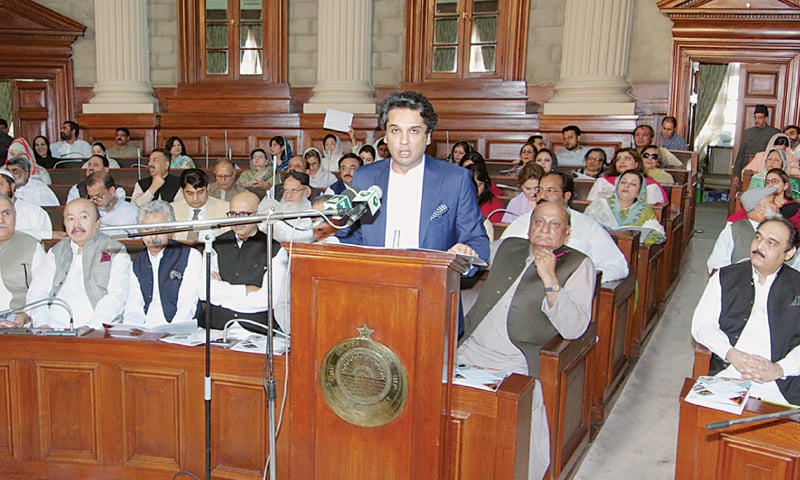LAHORE/KARACHI: Punjab on Friday unveiled a Rs2.30 trillion budget, raising its current expenditure by a modest three per cent to Rs1.3tn for the next financial year, while Sindh presented a deficit-free budget of Rs1.217tr with a 15pc increase in salaries and pension of government employees. The Punjab government increased development spending by 47pc to Rs350 billion, and pledged to run a cash surplus of Rs232.9bn to meet a federal requirement to keep national fiscal deficit down at 7.2pc and make substantial changes in agriculture income tax and property tax regimes to mobilise additional revenues.
Presenting the budget in the Punjab Assembly, Finance Minister Makhdum Hashim Jawan Bakht claimed that the proposed budget was aimed at executing institutional reforms to change the administrative structure for laying the foundation for sustainable and fast economic growth to create jobs, remove regional development disparities and improve the quality of life of people.
He announced 5-10pc raise in salaries of government employees and increased the minimum wage to Rs17,500.
The low allocation of Rs350bn for development, which also includes foreign project assistance of Rs18.2bn, in spite of availability of financial resources and its pledge to produce a huge cash surplus instead indicate that the government of Chief Minister Usman Buzdar has chosen to follow the federal economic stabilisation policy aimed at contracting the economy instead of pursuing rapid growth as envisaged in its Punjab Growth Strategy 2023.
Both provinces hike minimum wage, govt salaries; acknowledge austerity as need of the hour; growth to be sacrificed
The budget also plans to attract private investment of Rs42bn under the public-private partnership mode for building infrastructure in the province, which is 12pc of its budgeted development expenditure.
The provincial government expects its share from federal tax divisible pool to grow by a quarter to Rs1.6tr while projecting a modest increase of 7pc in its tax revenue to Rs294.9bn from a year ago. A major chunk of tax income will come from provincial sales tax on services and urban immovable property tax. The province has estimated its non-tax income to be around Rs93.4bn, which includes payment of net hydel profits of Rs32bn by Islamabad.
The minister announced that the provincial cabinet members had agreed to voluntarily cut of 10pc in their salaries in line with the austerity measures implemented by the federal government and the armed forces. The major provincial current spending comprises pay and pension expenditure of Rs582bn, debt (principle) repayment of Rs49bn and an expense of Rs279.2bn on service delivery. The local governments will receive Rs437bn for meeting their own expenditure.
The government has allocated Rs9.8bn for its social protection programme — Punjab Ehsaas Programme — to provide cash support to the elderly, disabled persons, orphans, widows, transgender people and government employees who lose life in terror attacks.
The minister also announced steps being executed for industrialisation in the province, to improve health and education facilities and develop agriculture and irrigation sectors for speeding up economic growth over the next few years. He announced several projects relating to healthcare, education, infrastructure, water and others for the backward districts of south Punjab.

Sindh budget
Presenting the Rs1,217bn “zero-deficit budget” for 2019-20 in the Sindh Assembly amid noisy protest by opposition parties, Chief Minister Syed Murad Ali Shah said the Centre had revised federal transfers from estimates of Rs665.085bn to Rs631.543bn, but “such claims are misleading”. He said the federal government failed to assess its own fiscal position and erroneously communicated two different figures of revised federal transfers within a matter of days.
“In the last 11 months, Sindh has received only Rs492.135bn on account of federal transfers and it is anticipated that by the end of [this] financial year the shortfall will be Rs117.527bn,” he added.
Revenue targets of the province have been revised to Rs240.746bn from Rs243.082bn. As a result, against an estimated budgetary amount of Rs1.123tr, the revised receipts for the current fiscal year stand at Rs963.699bn.
The government has earmarked Rs284.038bn for the annual development programme. The estimated ADP for the fiscal year 2018-19 was Rs343.91bn, which was revised downward to Rs172.941bn, citing depleted federal transfers.
“This has affected development endeavours of the provincial government. Many development schemes that could have been completed have been delayed due to non-availability of funds,” the chief minister regretted.
Similarly, on the current revenue side, estimates have been revised from Rs773.237bn to Rs751.751bn. The reduction on the current revenue side is primarily because of the “severe austerity measures and strict financial discipline”.
Total receipts of the province for the financial year 2019-20 are estimated at Rs1.217tr against an estimated expenditure of Rs1.217tr. As federal transfers, the province is expected to receive Rs835.375bn. Receipts from the federal government will account for 74.3pc of the total receipts.
On the current revenue side, CM Shah said, the expenditure budget was estimated at Rs870.217bn, which showed an increase of 12.5pc over the current year’s allocation of Rs773.237bn.
He said the development portfolio included Rs228bn on account of provincial and district ADP.
The allocation for school education has been increased from Rs170.832bn to Rs178.618bn. On development side, Rs15.15bn has been allocated. The current revenue expenditure of health department, excluding medical education, has been increased by 19pc to Rs114.4bn from Rs96.8bn. The allocation for the law and order sector has been increased in non-development budget from Rs100.483bn in 2018-19 to Rs109.788bn for the next fiscal year.
Besides, budget allocations for women, minorities and disabled persons have been increased, road sector is being prioritised and energy sector is being taken care of.
The chief minister said the agriculture department’s allocation for ADP 2019-20 was pitched at Rs8.4bn, which included Rs4.7bn of foreign assistance.
The chief minister announced an increase of 15pc in salaries as ad hoc relief allowance for all employees. The pensioners will also be entitled to get 15pc raise in their pensions. He announced Rs17,000 as minimum wage.
Published in Dawn, June 15th, 2019














































